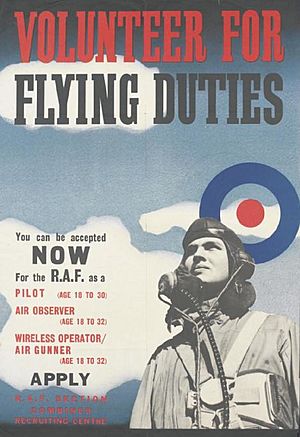Peter Parrott (RAF officer) facts for kids
Quick facts for kids
Peter Laurence Parrott
|
|
|---|---|

Volunteer for flying duties art (Peter Parrott)
|
|
| Nickname(s) | Polly |
| Born | 28 June 1920 Haddenham, Buckinghamshire, England |
| Died | 27 August 2003 (aged 83) |
| Allegiance | United Kingdom |
| Royal Air Force | |
| Years of service | 1938–1965 |
| Rank | Wing commander |
| Service number | 41054 |
| Commands held | No. 43 Sqn No. 111 Sqn |
| Battles/wars | Battle of France Battle of Britain |
Peter Parrott (28 June 1920 – 27 August 2003) was a brave pilot during World War II. He flew fighter planes in important battles like the Battle of France and the Battle of Britain. Later, he became a test pilot for the Royal Air Force (RAF) and retired in 1965. Even though he won special medals like the Distinguished Flying Cross (DFC) and the Air Force Cross (AFC), many people knew him best as the face of an RAF recruitment poster. An auction house later said that he "did more in 1940, aged just 19, than most people experience in a lifetime."
Contents
Early Life and Education
Peter Lawrence Parrott was born in Haddenham, Buckinghamshire, England, in June 1920. He went to Lord Williams's Grammar School in Thame, Oxfordshire. Even though many people in his family were lawyers, Peter chose a different path. After finishing school, he worked for the Buckinghamshire County Council for a while.
Joining the Royal Air Force
In 1938, Peter Parrott joined the RAF. He started his flight training at No. 1 Elementary and Reserve Flying Training School. After that, he moved to No. 11 Elementary Flying School at RAF Shawbury.
In 1939, he was sent to RAF Catfoss. There, he helped by towing targets for pilots to practice shooting. In January 1940, he joined No. 607 Squadron in France. He first flew Gloster Gladiator planes. By April 1940, he switched to flying Hawker Hurricane fighter planes. Peter was the only pilot in his squadron with experience flying the Hurricane at that time.
Flying in World War II
The famous picture of Peter Parrott on the RAF recruitment poster was taken when he was in northern France. He was giving a demonstration for war reporters. An RAF photographer asked him to look at the roof of a Nissen hut. Peter said he didn't see anything interesting, but as he looked up, the photographer quickly took the picture. When Peter returned to England, he saw his face on posters everywhere.
Peter flew many missions over northern France, fighting against German aircraft. In May 1940, he learned that his brother, who was also a pilot, was missing. Peter was allowed to go home for a short break. While he was there, he received a message telling him to report to No. 145 Squadron at RAF Tangmere. While flying with this squadron, Peter's plane was shot down. He crash-landed in a field near Deal in Kent and was rescued by staff from RAF Manston.
In August 1940, Peter shot down a Junkers Ju 87 Stuka bomber. This German plane had been attacking ships off the English coast. The Stuka crashed on the Isle of Wight. He also shot down an ME 109 and a JU 88. In September 1940, he was moved to No. 605 Squadron. In October 1940, Peter received the Distinguished Flying Cross (DFC) medal. This was because of his brave actions in defending Britain since January 1940. It was noted that he had shot down at least six enemy aircraft.
In April 1941, Peter was sent to the Central Flying School and other bases like RAF Hullavington and RAF Tern Hill. His job there was to teach other pilots. After this, he spent a short time with No. 57 Operational Training Unit. Then, he was posted to No. 501 Squadron at RAF Martlesham Heath. Soon after, he was sent to No. 72 Squadron, which was based in Malta.
In 1943, Peter Parrott joined No. 43 Squadron in Italy, near Naples. He was promoted to squadron leader shortly after arriving. He briefly led No. 111 Squadron before returning to No. 43 Squadron. In November 1943, Peter became the commanding officer of No. 43 Squadron. He held this important role until March 1944.
After the War
Peter Parrott received another medal, the Air Force Cross, in 1952. After World War II, he became a test pilot for the RAF. He retired from the RAF in 1965 with the rank of wing commander.
After leaving the RAF, Peter had several different jobs. One of these jobs involved flying for the Libyan authorities. In 1973, he was asked to fly to Uganda to pick up Idi Amin. This was during the Arab-Israeli War. When Peter and his team arrived at Entebbe Airport, they were held and questioned. The Ugandan authorities thought they might be mercenaries, which are soldiers who fight for money.
Family Life
Peter Parrott married Mary Dunning in 1948. During the war, Mary was part of the WAAF. She worked at a special listening station called a Y station at RAF Chicksands. Peter and Mary had two children together.
Peter Parrott passed away on 27 August 2003. In January 2022, his medals were sold at an auction. His brother's medals were also sold at the same time. His brother, Flying Officer Thomas Hayward Parrott, was a pilot who died in 1940. The collection of medals sold for a lot of money, showing how important their service was.

